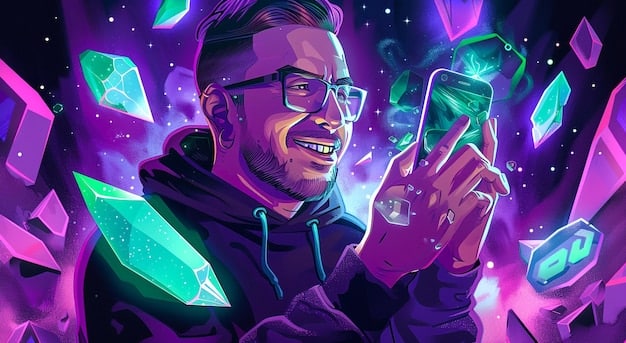Blockchain Gaming: NFTs & Crypto for US Developer Engagement

Blockchain gaming presents US developers with a unique opportunity to enhance player engagement through the integration of NFTs and cryptocurrencies, fostering innovative game mechanics and player-driven economies.
The gaming industry is constantly evolving, and blockchain technology is at the forefront of this transformation. For US developers, understanding how to leverage NFTs (Non-Fungible Tokens) and cryptocurrencies is becoming increasingly crucial. Blockchain Gaming: How US Developers Can Leverage NFTs and Crypto for Player Engagement offers a powerful pathway to create more immersive, rewarding, and ultimately, engaging gaming experiences.
Understanding the Basics of Blockchain Gaming
Blockchain gaming refers to video games that incorporate blockchain technology, which often includes NFTs and cryptocurrencies. This integration allows for features like true digital ownership, play-to-earn mechanics, and decentralized gaming ecosystems. US developers who grasp these fundamentals can unlock new levels of player engagement and monetization.
What is Blockchain Technology?
At its core, blockchain is a decentralized, immutable ledger that records transactions across many computers. This technology provides transparency, security, and trust, making it ideal for applications where data integrity is paramount. For gaming, this translates to secure ownership of digital assets and verifiable scarcity.
The Role of NFTs in Gaming
NFTs represent unique digital assets that can be owned, traded, and used within blockchain games. These assets can range from in-game items and characters to virtual land and collectibles. The key value proposition of NFTs is that they give players true ownership of their digital assets, which can then be used, sold, or transferred outside the game ecosystem.
- True Digital Ownership: Players genuinely own their in-game assets, not the game developer.
- Scarcity and Value: NFTs can be provably scarce, increasing their value and desirability.
- Cross-Game Interoperability: Some NFTs can be used across multiple games and metaverses.
Essentially, blockchain and NFTs introduce new ways for players to interact with games. US developers are now looking at how to leverage these benefits.

In conclusion, understanding the fundamental building blocks of blockchain gaming – the underlying technology and the role of NFTs – is essential for any US developer looking to innovate in this space. By leveraging blockchain technology, developers can provide gamers with the means to truly own their gaming experience.
Benefits of Integrating NFTs and Crypto for US Developers
Integrating NFTs and cryptocurrencies into games is not just a technological upgrade; it’s a fundamental shift in the relationship between developers and players. For US developers, this presents numerous benefits, including increased engagement, new revenue streams, and enhanced player loyalty.
Enhanced Player Engagement
When players have true ownership of in-game assets, they become more invested in the game’s ecosystem. The ability to earn, trade, and collect NFTs adds a layer of depth and strategy that traditional games often lack. This increased involvement can lead to higher retention rates and more active player communities.
New Revenue Streams
NFTs and crypto offer developers diversified revenue streams. Beyond traditional in-app purchases, developers can earn royalties from NFT sales on secondary markets and create tokenized game economies that reward both players and creators.
Building Stronger Communities
Blockchain gaming can foster a sense of community among players who share a common interest in the game and its underlying technology. NFT ownership can also grant access to exclusive content, events, and governance rights, further strengthening community ties.
- NFT Sales: Initial sales of NFTs generate revenue for developers.
- Royalties: Developers earn a percentage of each NFT sale on secondary markets.
- Tokenized Economies: Games issue their own cryptocurrencies, used for in-game transactions.

Ultimately, integrating NFTs and crypto can provide numerous benefits to US developers looking to create compelling environments. By leveraging the power of blockchain technology and NFTs, developers can cultivate strong communities.
Strategies for US Developers to Leverage Blockchain Gaming
US developers looking to capitalize on blockchain gaming can employ various strategies to create engaging and successful titles. These strategies involve careful planning, thoughtful implementation, and a deep understanding of the target audience.
Designing Play-to-Earn Mechanics
Play-to-earn (P2E) mechanics reward players for their time and effort by allowing them to earn cryptocurrencies or NFTs that can be sold or traded. Designing these economies requires careful balancing to ensure sustainability and prevent inflation.
Creating Unique NFT Collections
NFT collections can be used to represent characters, items, or land within the game. The key is to create NFTs that are visually appealing, functionally useful, and have a compelling backstory. Limited edition NFTs can also create hype and drive demand.
Implementing Governance Tokens
Governance tokens allow players to participate in the game’s decision-making process. By holding these tokens, players can vote on proposed changes, new features, and other aspects of the game, giving them a sense of ownership and influence.
Blockchain Gaming: How US Developers Can Leverage NFTs and Crypto for Player Engagement depends on using key strategies.
- Strategic Partnerships: Collaborate with other blockchain projects, DAOs (Decentralized Autonomous Organizations), and gaming communities.
- Community Engagement: Actively engage with players through social media, Discord, and in-game events.
- Iterative Development: Continuously update and improve the game based on player feedback and market trends.
In conclusion, a strategic approach to incorporating blockchain elements is vital for any US game developer. By adopting these strategies, US-based game developers can unlock the full potential of blockchain to create more engaging, transparent, and rewarding gaming experiences for players worldwide, helping them to thrive in this exciting and evolving space.
Overcoming Challenges in Blockchain Game Development
While blockchain gaming offers significant opportunities, it also presents unique challenges for US developers. Addressing these challenges is crucial to ensure the success and sustainability of blockchain game projects.
Scalability Issues
Blockchain networks can sometimes struggle to handle the high transaction volumes required by popular games. Layer-2 scaling solutions, sidechains, and other technologies can help mitigate these issues.
Regulatory Uncertainty
The legal and regulatory landscape surrounding cryptocurrencies and NFTs is still evolving, particularly in the US. Developers need to stay informed about relevant regulations and ensure compliance to avoid legal issues.
Complexity and User Experience
Blockchain technology can be complex for non-technical users. Developers need to prioritize user-friendly interfaces and onboard experiences to make blockchain games accessible to a wider audience.
- Education: Provide clear and concise information about blockchain and NFTs.
- Simplified Onboarding: Streamline the process of creating wallets and acquiring cryptocurrencies.
- Security Audits: Regularly audit smart contracts and game code to identify and fix vulnerabilities.
Addressing scalability concerns, navigating regulatory challenges, and ensuring a seamless user experience are crucial steps for US developers. This would help create games that are not only engaging but also sustainable in the long term.
Future Trends in Blockchain Gaming
The world of blockchain gaming is continuously evolving, with new trends and technologies emerging regularly. Understanding these trends is vital for US developers to stay competitive and innovative.
Metaverse Integration
Integrating blockchain games with metaverses allows players to use their NFTs and cryptocurrencies across multiple virtual worlds. This creates a more interconnected and immersive gaming experience.
Mobile Blockchain Gaming
As mobile gaming continues to grow, there is increasing demand for blockchain games that can be played on smartphones and tablets. Optimizing blockchain games for mobile devices is a key growth opportunity.
AI and Blockchain Gaming
The fusion of artificial intelligence (AI) with blockchain gaming can unlock new possibilities, such as AI-powered NFTs, personalized gaming experiences, and more dynamic game environments.
Blockchain Gaming: How US Developers Can Leverage NFTs and Crypto for Player Engagement is evolving quickly.
- Cloud Gaming: Stream blockchain games directly to devices without requiring downloads or installations.
- Cross-Chain Interoperability: Enable NFTs and cryptocurrencies to be transferred and used across different blockchain networks.
- Enhanced Security Measures: Implement advanced security protocols to protect players’ assets and data.
In summary, the future of blockchain gaming depends on adapting to emerging trends, making it a vital area of innovation for US developers. By keeping an eye on upcoming trends and embracing new technologies, game developers can make games that meet needs.
Case Studies: Successful Blockchain Games
Examining successful blockchain games and their innovative use of NFTs and cryptocurrencies can provide valuable insights for US developers. By analyzing these case studies, developers can understand what works and what doesn’t in this emerging space.
Axie Infinity
Axie Infinity is a play-to-earn game where players collect, breed, and battle digital creatures called Axies, which are represented as NFTs. The game’s robust economy and engaging gameplay have made it one of the most successful blockchain games to date.
Decentraland
Decentraland is a virtual world where players can buy, sell, and build on virtual land represented as NFTs. The platform allows users to create and monetize experiences, making it a hub for creativity and commerce within the metaverse.
The Sandbox
The Sandbox is a user-generated content platform where players can create, share, and monetize voxel-based assets and games. The platform’s intuitive tools and robust NFT marketplace have made it a popular choice for creators.
These case studies highlight successes in Blockchain Gaming: How US Developers Can Leverage NFTs and Crypto for Player Engagement.
- Strong Tokenomics: Games with sustainable token economies tend to perform better.
- Compelling Gameplay: Engaging and fun gameplay is crucial for attracting and retaining players.
- Community Focus: Games that prioritize community building and engagement are more likely to succeed.
| Key Point | Brief Description |
|---|---|
| 🎮 NFT Integration | Enhances player engagement through digital ownership. |
| 💰 Play-to-Earn | Rewards players, driving game adoption and activity. |
| 🌐 Metaverse Integration | Expands utility of NFTs across virtual worlds. |
FAQ
Integrating NFTs in blockchain gaming provides true digital ownership to players, allowing them to own, trade, and use their in-game assets across different platforms. This enhances player engagement and creates new economic opportunities within the gaming ecosystem.
US developers should consult with legal experts specializing in cryptocurrency and blockchain regulations. Staying informed about evolving laws and implementing robust KYC/AML processes are crucial for maintaining compliance and avoiding legal issues.
US developers can implement balanced tokenomics, introduce sinks to reduce token supply, and design engaging gameplay loops that reward players fairly. Regular monitoring and adjustments based on player activity are also vital for maintaining equilibrium in the game’s economy.
Key challenges include scalability issues, regulatory uncertainty, and complexity for non-technical users. Addressing these challenges involves optimizing blockchain networks, staying informed about legal requirements, and prioritizing user-friendly interfaces.
Metaverse integration enables players to use their NFTs and cryptocurrencies across various virtual worlds, creating a more interconnected and immersive gaming environment. This expands the utility of digital assets and fosters a sense of community among users.
Conclusion
In conclusion, Blockchain Gaming: How US Developers Can Leverage NFTs and Crypto for Player Engagement offers a path to create innovative and immersive gaming experiences. By understanding the basics, addressing the challenges, and embracing the future trends, US developers can thrive in this rapidly evolving space, delivering real value to players.





